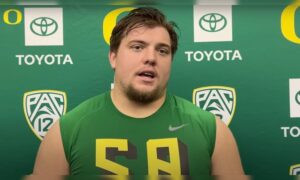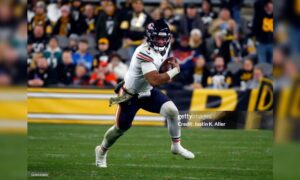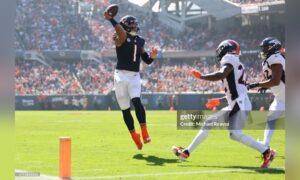By Matthew Marczi
Given all that has happened over the past few weeks with the inside linebackers, I was feeling somewhat confident that I would be seeing Vince Williams announced with the starting lineup tomorrow, getting the nod over Kion Wilson, over whom he has been seeing twice as many snaps anyway. And after all, what’s in a name?
After re-watching the Chicago Bears game, I continue to feel reassured that the reported first-team reps that Williams received this week was no mere coincidence. While he did not have a perfect game by any means, I did like quite a bit out of what I saw from him, in particular his ability to quickly diagnose a play and then rapidly act upon it. That is the “see-to-do” that you may hear uttered by the likes of Craig Wolfley and Tunch Ilkin.
Make no mistake, Williams still has his flaws. After all, there is a reason that he was still undrafted during the compensatory selections of the sixth round of this year’s draft. His biggest issue, as linebackers coach Keith Butler has described it, is that he has a tendency not to “bring his feet” when he tackles sometimes, and that was evident on a number of plays during the night.
One of those plays was the fourth and goal play in which the Bears scored, although he also appeared to stumble a bit over the feet of Steve McLendon. The play before, however, showed great situational awareness, even if I remain unconvinced that he actually prevented the ball from crossing the goal line despite doing everything in his power to prevent it.
On the play, Williams has the responsibility of covering the hole through which the back carries the ball. Williams actually takes somewhat of a circuitous route to the ball carrier, sort of leveraging around him and grasping at his arms. I certainly have my questions as to whether or not it was intentional. Still, he had the presence of mind to use his own arm to press it up against the ball in order to prevent the back from advancing it further, even as his body moved forward. It was a heady play, even if he initially took the wrong angle.
Williams has a better opportunity to demonstrate his quickness and awareness when not backed up against his own goal line, however. For instance, on the Bears’ first drive of the second quarter. Curtis Brown backed the Bears up to their own seven-yard line.
On the ensuing first down, Williams is quick to diagnose not only the play, but where it is heading. He meets the pulling guard, Matt Slauson, head on, and sheds him with relative ease and brings the ball carrier down after a short gain.
Later on, to end the second half, Williams and Lawrence Timmons read the wide receiver shift and shift themselves accordingly before the play.
Here, he is able to swim through traffic and avoid the reach of right guard Kyle Long, who I might add was tied up to a double team on McLendon. The double team allows Williams to weave his way unabated to the ball carrier, as Brandon Marshall—evidently assuming that Williams will have been picked up as the play was designed—looks back to help on another block. That block ended up being behind the play, as Williams was already at the ball carrier, and Timmons helped clean up the job.
Williams and Timmons were able to work well throughout the game, which is another factor to consider when determining who to play alongside him. If Williams allows Timmons to play to his natural abilities, that is truly an unquantifiable asset. If he were forced to stay home and babysit a rookie linebacker, the defense as a whole would be greatly diminished. Fortunately, the tape shows that that will not be necessary.










